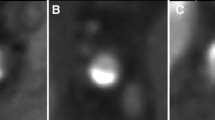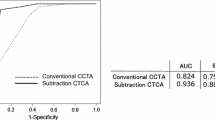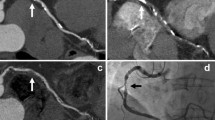Abstract
Multi-detector computed tomography (MDCT) has been used for detecting or excluding coronary atherosclerotic stenosis in symptomatic patients. However, the role of MDCT for routine medical examination in asymptomatic, high-risk patients has not been established. We therefore conducted the present study to test the hypothesis that MDCT could be a valuable method for detecting subclinical coronary artery stenosis in asymptomatic patients. An observational, retrospective, single-centre study was conducted with a cohort of 1,529 patients (mean age, 56.4 ± 8.3 years; 1,353 males) who had undergone MDCT as part of their general medical checkups from November 2005 to April 2008. The patients who had a past history of coronary artery disease, typical chest pain, or evidence of myocardial ischemia were excluded. During clinical follow up of these patients, the incidence of subclinical coronary stenosis and the usefulness of MDCT for routine medical examination in asymptomatic patients were investigated. Of the 1,529 enrolled patients, 42.3% had hypertension, 13.5% had diabetes mellitus, 7.7% had hyperlipidemia, and 40.4% were current smokers. Abnormal MDCT findings were noted in 560 (36.6%) patients, who were classified into two groups. One group had the presence coronary calcium with a luminal diameter stenosis of the coronary artery of <50% (n = 508, 33.2%). These patients were treated with medication or clinical follow-up. The other group had a luminal diameter stenosis of the coronary artery of ≥50% with the presence or absence of coronary calcium (n = 52, 3.4%). These patients underwent a conventional coronary angiogram and intravascular ultrasound. A total of 29 of the 1,529 patients (1.9%) presented with insignificant stenosis or myocardial bridge, and 23 patients (1.5%) presented with significant stenosis. The patients with significant stenosis underwent percutaneous coronary intervention (PCI) with stent implantation. Major adverse cardiac events occurred in only 2 patients who had been treated with PCI during a mean follow-up period of 387 ± 253 days. The incidence of significant subclinical coronary stenosis as detected by MDCT in a general medical check-up was 3.4%, and the false-positive rate of MDCT for detecting significant coronary artery stenosis was 55.8% (29/52). 64-Slice MDCT can be a useful tool for noninvasive evaluation of coronary arteries in asymptomatic patients. Further study is needed to clarify the clinical implications of MDCT in general medical check-ups.
Similar content being viewed by others
Explore related subjects
Discover the latest articles, news and stories from top researchers in related subjects.Avoid common mistakes on your manuscript.
Introduction
Multi-detector computed tomography (MDCT) has been shown to permit the visualization of the coronary artery lumen and the detection of plaque morphology with good correlation to intravascular ultrasound (IVUS) [1]. Additionally, scans performed by the MDCT technique are relatively simple and convenient for the patient, who needs only to lie quietly in the CT scanner for approximately 10 min. Usually, minimal special preparation is required for the test, and there are only minor restrictions on the types of medication that can be taken before or during the test. Therefore, MDCT has been used for detecting or excluding coronary atherosclerotic stenosis in symptomatic patients [2, 3]. MDCT does have several disadvantages; however, such as a tendency to overestimate the degree of stenosis compared with that estimated by conventional coronary angiogram (CCA) [4], a high cost, and a high radiation dose [5].
The role of MDCT for routine medical examination in asymptomatic, high-risk patients has not been established [6–8]. The possibility exists, however, that the new 64-slice MDCT might represent an ideal noninvasive imaging technique for coronary anatomy. We therefore conducted the present study to test the hypothesis that MDCT could be a valuable method for detecting subclinical coronary artery stenosis in asymptomatic patients.
Materials and methods
Study population and design
From November 2005 to April 2008, 1,649 patients at the Chonnam National University Medical Center underwent MDCT as part of their general medical check-up. Among the patients who underwent MDCT successfully, 83 (5.0%) were excluded from this study because of a past history of coronary artery disease, 34 (2.1%) were excluded because of typical chest pain, and 3 (0.2%) were excluded because laboratory tests and electrocardiogram (ECG) or echocardiogram results showed evidence of myocardial ischemia. Therefore, 1,529 patients (mean age, 56.4 ± 8.3 years; 1,353 males) were enrolled in this study (Fig. 1).
All patients underwent standard clinical and diagnostic evaluation, including routine laboratory tests and standard 12-lead ECG. Patients with abnormal MDCT findings were stratified into two groups. One group had the presence of coronary calcium but had a luminal diameter stenosis of the coronary artery of <50%. These patients were treated by medication and clinical follow-up. Clinical follow-up consisted of outpatient department visits every 1–3 months or an emergency room visit if they experienced severe chest pain, dyspnea, or palpitations.
The second group had a luminal diameter stenosis of the coronary artery of ≥50% with the presence or absence of coronary calcium. These patients underwent CCA and IVUS. Patients with significant stenosis shown by both CCA and IVUS underwent percutaneous coronary intervention (PCI) with stent implantation according to the coronary anatomy and evidence of myocardial ischemia. Patients with insignificant stenosis were treated medically and with clinical or CCA follow-up (Fig. 1).
Cardiac MDCT
All patients with a resting heart rate of >70 bpm and no contraindications (contraindication to intravenous contrast agents [contrast allergy], elevated serum creatinine [>1.3 mg/dL], atrial fibrillation or frequent ventricular ectopy [>10 extra systoles per minute], or a heart rate >90 bpm) received 50–100 mg of oral metoprolol 1–2 h before the scan. Blood pressure and pulse were rechecked right before the procedure. The MDCT examinations were performed with a two-phase, contrast-enhanced, ECG-gated, MDCT scanner (Sensation Cardiac 64, Siemens, Forchheim, Germany) set at a 0.75-mm section thickness with a gantry rotation time of 330 ms and a kernel value of B25f. The tube current was 800 mAs at 120 kVP. The pitch, defined as the ratio of the table feed in one rotation over the detector coverage in the transverse direction, was determined as 0.2. The scan delay was determined by using the bolus tracking technique as follows: when a threshold of 120 Hounsfield units (HU) was reached in the ascending aorta at the level of the origin of the coronary arteries, a delay of 5 s was applied before the scan was initiated. Serial CT scanning in the axial plane, together with a ECG-triggered examination, was performed from the level of the left ventricular apex after a bolus injection of 60 mL of nonionic contrast media (Ultravist 370®, Bayer Schering Pharma, Berlin, Germany) followed by a 60-mL saline bolus injection, both of which were injected at a flow rate of 4 mL/s. The radiation dose was variable according to the body mass index and heart rate of the patients, 0.8–1.3 mSV in flash mode, 5–8 mSV in sequence mode, and 10–13 mSV in conventional mode.
All CT images were analyzed by a radiologist with 5 years’ of experience in coronary CT imaging. The axial images were reconstructed at multiple phases that covered the cardiac cycle in increments of 10% of the RR interval between 5 and 95%. Multiphase reconstruction was performed by using short axis slices from the base to the apex of the heart with the use of commercially available software (Argus®, Siemens).
Conventional coronary angiography
The CCA and IVUS were performed at a mean of 31.5 days after MDCT. CCA was performed by using digital flat panel fluoroscopy (Phillips) via a femoral approach with the application of nonionic contrast material (Ultravist® 370, Bayer Schering Pharma, Berlin, Germany). A minimum of four orthogonal views were obtained in each coronary artery.
Statistical analysis
SPSS for Windows, version 15.0 (Chicago, IL, USA) was used for all analyses. Continuous variables are presented as the mean value ± SD; comparisons were conducted by Student’s t test. Discrete variables are presented as percentages and relative frequencies; comparisons were made by using chi-square statistics or Fisher’s exact test, as appropriate. Logistic regression analysis was performed to identify the independent predictors of subclinical significant coronary stenosis in CCA. The 95% confidence interval for the relative risk was calculated by using standard errors from the Kaplan–Meier curve. A P value of <0.05 was considered statistically significant.
Results
Baseline clinical characteristics
Hypertension was present in 647 patients (42.3%), diabetes mellitus in 206 patients (13.5%), hyperlipidemia in 118 patients (7.7%), and current smoking in 618 patients (40.4%). The laboratory findings were shown in Table 1.
MDCT and Conventional coronary angiographic findings
Of the 1,529 patients included in the analysis, 969 (63.4%) patients presented with normal findings and 560 (36.6%) patients presented with abnormal findings in the MDCT. Among the patients with abnormal findings, 508 (90.7%) patients had the presence of coronary calcium but a luminal diameter stenosis of the coronary artery of <50%. The remaining 52 (9.3%) patients had a luminal diameter stenosis of the coronary artery of ≥50% with the presence or absence of coronary calcium. Eighteen patients had a total coronary calcium score of >400 points. Significant coronary artery stenosis was most frequent in the left anterior descending artery (43 patients).
A total of 29 patients (29/52, 55.8%) showed insignificant stenosis or myocardial bridge on the CCA. A total of 23 patients (23/52, 44.2%) showed significant stenosis on the CCA. Of the patients with significant stenosis, 13 (56.5%) patients had hypertension, eight (34.8%) patients had diabetes mellitus, three (13.0%) patients had hyperlipidemia, and 10 (43.5%) patients were current smokers. Twelve patients had one-vessel disease, seven patients had two-vessel disease, and four patients had three-vessel disease. The affected artery was the left anterior descending artery in 16 patients, the left circumflex artery in 10 patients, the right coronary artery in seven patients, and the left main artery in two patients (Table 2). The patients with significant stenosis underwent PCI with stent implantation according to their coronary anatomy and evidence of myocardial ischemia.
In a multivariate regression analysis, independent predictors of subclinical significant coronary stenosis on the CCA were diabetes mellitus (odds ratio, 1.77; 95% confidence interval [CI], 1.06–2.94; P = 0.029), a high level of homocysteine (odds ratio, 2.30; 95% CI, 1.05–5.05; P = 0.038), and old age (odds ratio, 1.39; 95% CI, 1.01–1.90; P = 0.044).
During a mean clinical follow-up period of 387 ± 253 days, major adverse cardiac events occurred in only two patients (target lesion revascularizations) who had been treated with PCI.
Discussion
Flow-mediated dilation of the brachial artery, carotid intima-media thickness, and pulse wave velocity have been shown to be good surrogate markers of clinical atherosclerosis [9–11]. The great attraction of coronary angiography for both patients and physicians is the direct view of those small structures, the integrity of which may dictate life or death [8]. In patients with suspected coronary artery disease, CCA may provide accurate information. However, in the asymptomatic general population with or without risk factors for coronary artery disease, CCA is too invasive, too expensive, and it is not effective from the viewpoint of the risk–benefit model. Therefore, we used MDCT to detect subclinical coronary atherosclerosis in the healthy general population. MDCT has been shown to be a reliable diagnostic technique for the evaluation of coronary artery stenoses [12, 13]. Recent reports also suggest that 64-slice MDCT can detect coronary artery disease in asymptomatic, hypertensive, and high-risk patients [14]. Nonetheless, MDCT also has several disadvantages, such as a high cost, a high radiation dose, contrast-induced nephropathy, and oculo-stenotic reflex.
In our study, the incidence of subclinical significant coronary stenosis detected by MDCT in a general medical check-up was only 1.5%. Furthermore, the false-positive rate of MDCT for detection of significant coronary artery stenosis was 55.8% (29/52). This is a relatively high rate, although not all patients underwent CCA. The tendency of MDCT to overestimate the degree of stenosis compared with that of CCA is well known [4]. Therefore, we suggest that the role of MDCT as a screening test should not be overestimated and that these disadvantages should be considered before clinical implication for routine use.
In the subgroup analysis, the incidence of subclinical significant coronary stenosis was 2.0% in patients with hypertension, 3.9% in patients with diabetes mellitus, 1.6% in current smokers, and 2.5% in patients with hyperlipidemia. The incidence rate of subclinical atherosclerosis was higher in the patients who had risk factors for coronary artery disease, especially diabetes mellitus, than in the general population. In a multivariate regression analysis, diabetes was also the most important predictive factor of subclinical significant coronary stenosis in CCA. This finding may be explained by the higher rate of painless myocardial ischemia in diabetes [15].
Our study does have some limitations. First, not all patients underwent CCA. Therefore, we could not calculate the accurate sensitivity, specificity, positive predictive value, or negative predictive value of cardiac MDCT. Second, a control group of patients not undergoing cardiac MDCT was not included in our study. To elucidate the role of MDCT as a screening test, we will need to compare major adverse cardiac events during clinical follow-up between the cardiac MDCT group and a control group.
In conclusion, the incidence of subclinical significant coronary stenosis examined by cardiac MDCT in routine medical examination was 3.4%. However, the false-positive rate of MDCT for detection of significant coronary artery stenosis was 55.8%. Further analysis of the role of cardiac MDCT for noninvasive evaluation of coronary artery disease in asymptomatic patients will be needed in a large-scale study.
References
Pohle K, Achenbach S, Macneill B et al (2007) Characterization of non-calcified coronary atherosclerotic plaque by multi-detector row CT: comparison to IVUS. Atherosclerosis 190(1):174–180
Ropers D, Baum U, Pohle K et al (2003) Detection of coronary artery stenoses with thin-slice multi-detector row spiral computed tomography and multiplanar reconstruction. Circulation 107(5):664–666
Schroeder S, Kopp AF, Baumbach A et al (2001) Noninvasive detection and evaluation of atherosclerotic coronary plaques with multislice computed tomography. J Am Coll Cardiol 37(5):1430–1435
Groen JM, Greuter MJ, van Ooijen PM et al (2007) A new approach to the assessment of lumen visibility of coronary artery stent at various heart rates using 64-slice MDCT. Eur Radiol 17(7):1879–1884
Fei X, Du X, Li P et al (2008) Effect of dose-reduced scan protocols on cardiac coronary image quality with 64-row MDCT: a cardiac phantom study. Eur J Radiol 67(1):85–91
Hoffmann U, Brady TJ, Muller J (2003) Cardiology patient page. Use of new imaging techniques to screen for coronary artery disease. Circulation 108(8):e50–e53
Greenland P, Gaziano JM (2003) Clinical practice. Selecting asymptomatic patients for coronary computed tomography or electrocardiographic exercise testing. N Engl J Med 349(5):465–473
Sechtem U, Vöhringer M (2005) The clinical role of ‘non-invasive’ coronary angiography by multidetector spiral computed tomography: yet to be defined. Eur Heart J 26(19):1942–1944
Kobayashi K, Akishita M, Yu W et al (2004) Interrelationship between non-invasive measurements of atherosclerosis: flow-mediated dilation of brachial artery, carotid intima-media thickness and pulse wave velocity. Atherosclerosis 173(1):13–18
Hijmering ML, Stroes ES, Pasterkamp G et al (2001) Variability of flow mediated dilation: consequences for clinical application. Atherosclerosis 157(2):369–373
Simon A, Chironi G, Levenson J (2007) Comparative performance of subclinical atherosclerosis tests in predicting coronary heart disease in asymptomatic individuals. Eur Heart J 28(24):2967–2971
Butler J, Shapiro MD, Jassal DS et al (2007) Comparison of multidetector computed tomography and two-dimensional transthoracic echocardiography for left ventricular assessment in patients with heart failure. Am J Cardiol 99(2):247–249
Onuma Y, Tanabe K, Nakazawa G et al (2006) Noncardiac findings in cardiac imaging with multidetector computed tomography. J Am Coll Cardiol 48(2):402–406
Gaudio C, Mirabelli F, Pelliccia F et al (2009) Early detection of coronary artery disease by 64-slice multidetector computed tomography in asymptomatic hypertensive high-risk patients. Int J Cardiol 135(3):280–286
Culić V, Eterović D, Mirić D et al (2002) Symptom presentation of acute myocardial infarction: influence of sex, age, and risk factors. Am Heart J 144(6):1012–1017
Acknowledgments
This study was supported by a grant (A084869) of the Korea Healthcare technology R&D Project, Ministry for Health, Welfare & Family Affairs, Republic of Korea.
Author information
Authors and Affiliations
Corresponding author
Rights and permissions
About this article
Cite this article
Jeong, H.C., Ahn, Y., Ko, J.S. et al. The role of 64-slice multi-detector computed tomography in the detection of subclinical atherosclerosis of the coronary artery. Int J Cardiovasc Imaging 26 (Suppl 2), 253–259 (2010). https://doi.org/10.1007/s10554-010-9721-1
Received:
Accepted:
Published:
Issue Date:
DOI: https://doi.org/10.1007/s10554-010-9721-1





